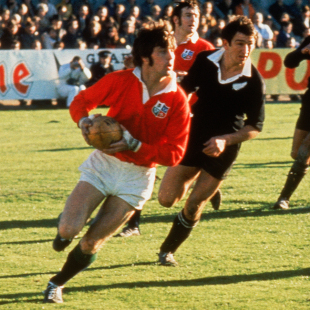|
England in New Zealand 2014
A forbidding place to visit
John Taylor
June 13, 2014

The Lions defeated the All Blacks 9-6 at Carisbrook on June 26, 1971 © Getty Images
Enlarge
Wet, windy, cold - 'bleak' to sum it up in a word. That was the norm on the three occasions I played in Dunedin and for most of the matches I watched from the press box over 25 years, so it was no surprise when we arrived for the 2011 World Cup to discover they had finally bitten the bullet and replaced Carisbrook with the Forsyth Barr Stadium - the first indoor rugby ground in New Zealand. Dunedin is one of the friendliest cities in New Zealand but Carisbrook was always a forbidding place to visit. The ground itself was a strange hotchpotch of permanent and temporary stands - I believe they somehow increased the capacity to 45,000 for the first Test in 1971 - and if you could not get a ticket there was always space on the railway embankment up on the hill behind the main highway that skirted the ground. I was always too busy to notice but trains would apparently slow down or even stop so that passengers could watch when there was a big match being played. Reports from the time suggest that 8,000 more watched from the vantage point known as 'the Scotsman's Grandstand' when we upset the applecart in '71.

Barry John is pursued by Tane Norton
© Getty Images
Enlarge
That first Test in 1971 was obviously of paramount importance. Despite losing the very first game of the tour in Australia to Queensland which led to their coach, Des Connor, branding us as 'undoubtedly the worst team ever to be sent to New Zealand' we had surprised everybody by reeling off ten wins in a row once arriving there. Wellington, Otago and Canterbury, three of the top four Provinces, were among the victims so we had put down a marker but most New Zealanders expected the mighty All Blacks' forwards to put us firmly in our place. Having been a part of the Welsh tour two years earlier, when we had arrived full of hope as European Champions only to lose both Tests by 19 points - a huge margin in those days - I was very aware that this was a defining moment in my rugby career. The whole team, but the Welsh contingent in particular, felt we had to prove ourselves in the southern hemisphere. The Lions had not won a series against South Africa or New Zealand in the modern era and we were very aware that for most of us it was probably now or never. Canterbury had resorted to out-and-out thuggery the week before and had succeeded in putting Sandy Carmichael and Ray McLoughlin, our first choice props, out of the tour but if the aim was to intimidate us it had the opposite effect. It was a very fired-up group of wounded Lions that descended on Dunedin. It rained quite heavily through the week so, although the Saturday was fine, we were playing on the normal glutinous surface. We were almost a stone a man lighter in the pack - McLoughlin's replacement, Ian 'Mighty Mouse' McLaughlan weighing in at barely 15 stone - and most of the home pundits thought that would be crucial but we confounded everybody. The Lions' backs had set New Zealand alight but this was a day for the forwards and I just remember repelling wave upon wave of All Black attackers - I honestly cannot recall touching the ball more than a couple of times but my tackle count must have been huge.
The kickers certainly found conditions difficult with Barry John, who had been a revelation, missing a couple of early chances and Fergie McCormick, New Zealand's full-back, also missing from close range but midway through the half we took the lead with a try from an unexpected source - Mighty Mouse. Having weathered several New Zealand assaults we eventually had them under huge pressure on their own line and the diminutive prop was on hand to charge down Alan Sutherland's attempted clearance from the in goal area and make the touchdown. McCormick levelled things with a penalty - tries were only worth three points at that time - just before half-time but our confidence was growing. The second-half was just as frenetic with half chances for both sides before John nudged us ahead with a penalty and our self-belief soared when McCormick was again off target with a straightforward penalty chance. Finally, John sealed it with another penalty. My lasting memory for some reason is the pall of steam that rose from the forwards at the final whistle. Bleak it may have been but Carisbrook will always hold sweet memories as the place where we proved the All Blacks were not invincible. We lost the second Test at Christchurch but bounced back to win the third and draw the fourth to take the series. © ESPN Sports Media Ltd John Taylor is a former Wales international who toured with the British & Irish Lions in 1968 and 1971. Since retiring he has worked in the media and has covered the last eight Lions tours as a commentator or journalist
| |||||||||||||||
Live Sports
Communication error please reload the page.
-
Football
-
Cricket
-
Rugby
-
- Days
- Hrs
- Mins
- Secs
F1 - Abu Dhabi GP
Abu Dhabi Grand Prix December 11-131. Max Verstappen ()
2. Valtteri Bottas (Mercedes)
3. Lewis Hamilton (Mercedes)
4. Alexander Albon ()
5. Lando Norris ()
6. Carlos Sainz Jr ()
-
ESPNOtherLive >>
Snooker - China Open
Tennis - Miami Open

